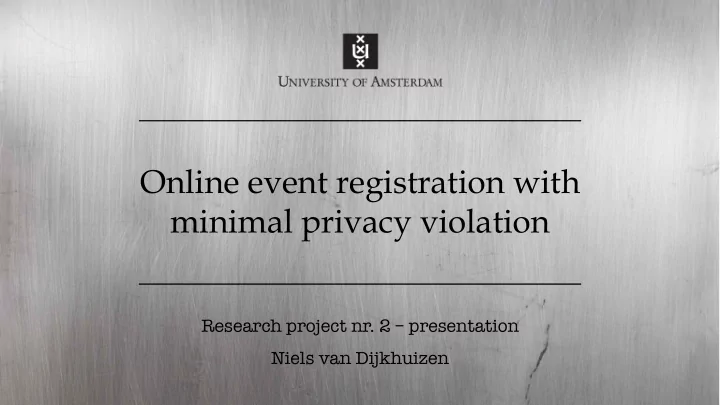

Online event registration with minimal privacy violation Research project nr. 2 – presentation Niels van Dijkhuizen
Introduction
Sharing captured network data
IDS rule
Privacy concerns Image source: www.birminghamavs.com/tag/surveillance-cameras
Research Question Is it possible to create a system that indicates network threats with minimal privacy violation?
Approach
Anonymisation example 1
Anonymisation example 1
Anonymisation example 1
Anonymisation example 2
Anonymisation example 2
Anonymisation example 2
Techniques and concepts Anonymisation or Pseudonymisation? Transformation primitives Image source: www.open.edu/openlearn/society/the-white-mask
Inference attacks Passive fingerprinting to infer objects and topology Active Data injection attack (chosen plaintext) Cryptographic attacks Even PETs are not safe! source: www.grumpycats.com
Requirements of the Anonymisation system Full support for Link-, Internet- and Transport layers; Features for application layer anonymisation; Real time processing network streams.
State of current tools
Speed improvements [1] Process parallelisation GPU Accelerated Crypto AES-NI, PadLock, etc. Image source: www.nvidia.com
Speed improvements [2] Special purpose capture cards Programmable NICs and FPGAs Random Number Generator Inline data anonymisation / filtering Image source: digilentinc.com/sume/
Suggestions
Plan Needed steps: Identify proto/apps; 1. Get statistics; 2. Identify threats; 3. Identify sensitive fields; 4. Build privacy and threat policies. 5.
Network native way Privacy Packets Threat rule-sets policies Identification IDS Further and Anonymisation Detection conditional classification Engine anonymisation Unknown is Alerts & discarded Storage Anonymiser Intrusion Detection
White fielding Privacy Packets Threat rule-sets policies Identification Erase irrelevant and Simplified IDS fields classification Unknown is Alerts & discarded Storage Intrusion Anonymiser Detection
Conclusions
Conclusions [1] It is possible to anonymise network traces to a certain extent and keep some of the usefulness for threat detection Image source: www.justice-for-families.org.uk/
Conclusions [2] Do not share complete datasets; Only specific new threat-related parts; Maturity of frameworks: Primitive enhancements; Improving of parsing; Speed / Scalability.
Acknowledgement
Recommend
More recommend